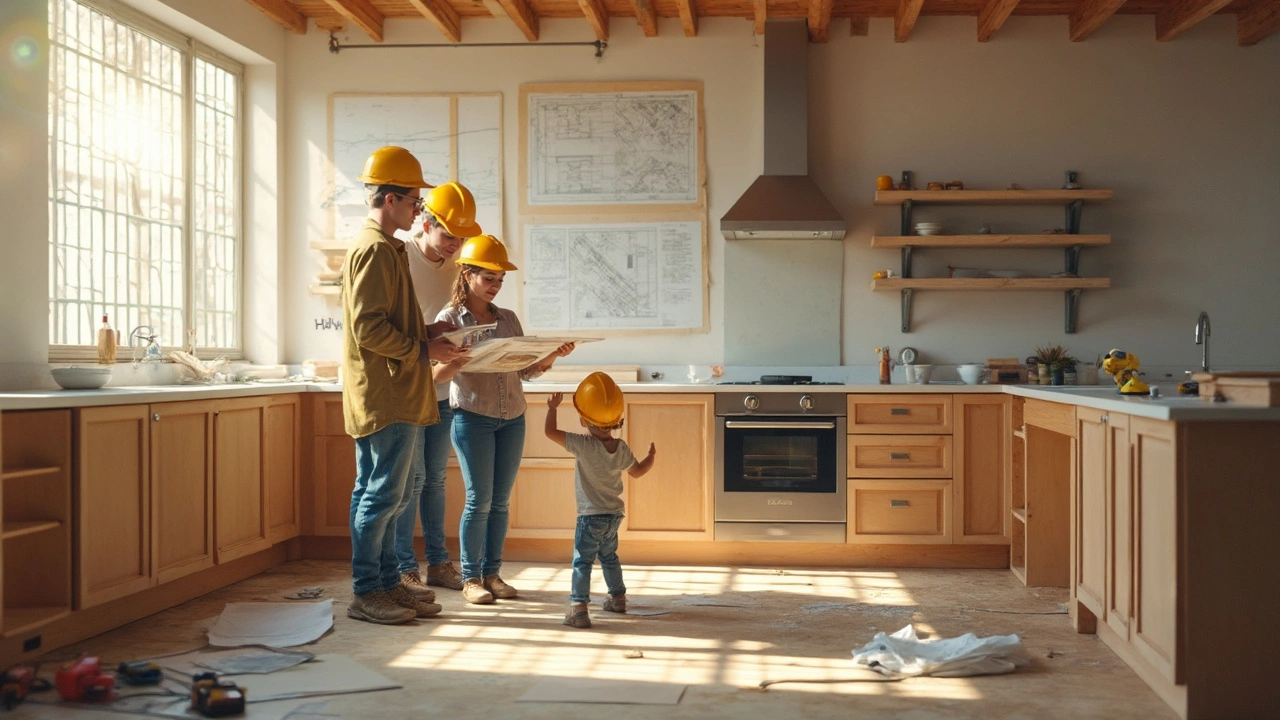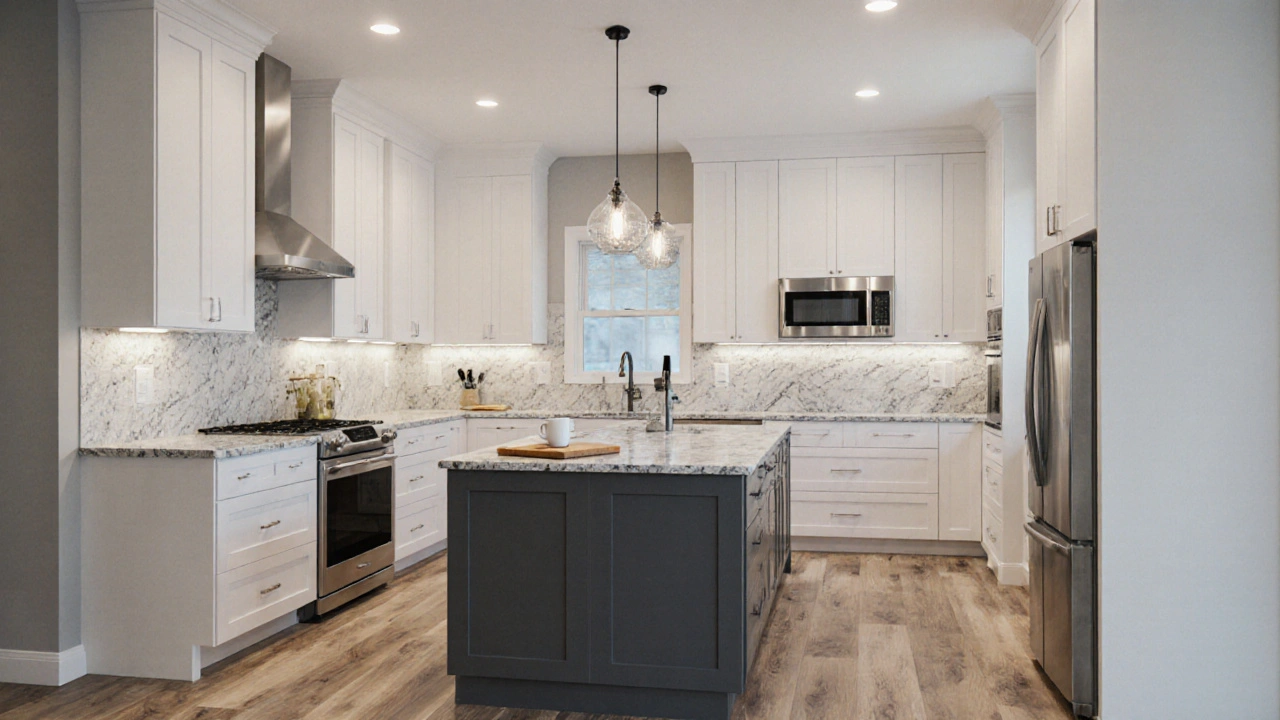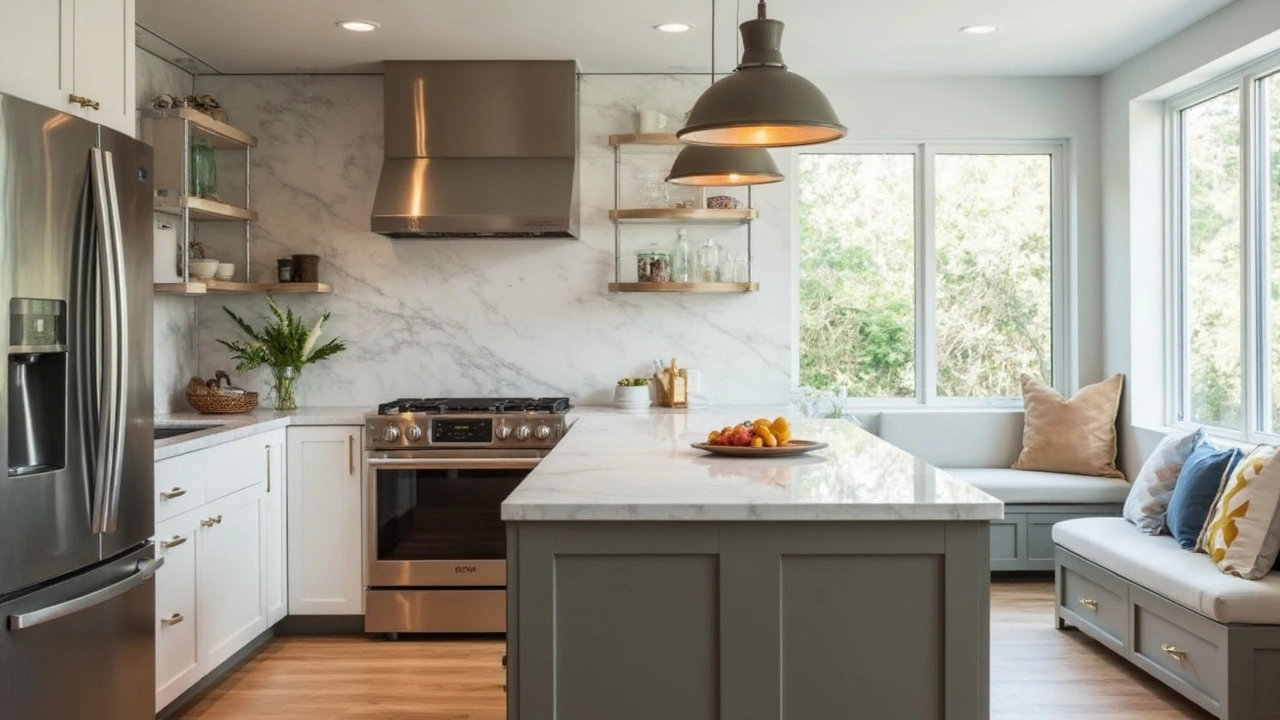Picture this: your old kitchen is barely hanging on. The doors squeak, the laminate peels, and the layout makes making coffee in the morning a full-blown obstacle course. The dream of a fresh, functional kitchen finally outweighs the dread, and you’re ready to remodel. But here’s the gut-punch: most people wildly underestimate what it actually costs to change up the heart of their home. Even if you’re a spreadsheet wizard, you won’t believe how quickly the numbers stack up. And it isn’t the stainless-steel fridge or the gleaming granite counters that turn your savings account upside down. The biggest single expense, hands down, is something hiding in plain sight.
The Cost Leader: Cabinets Eat the Budget
Ask anyone who’s braved a kitchen renovation what hit their wallet hardest, and you’ll hear it again and again: cabinets. It sounds boring, maybe even unfair, but cabinets can chew up to 40% of your entire kitchen remodel budget. For a typical mid-range kitchen reno in Canada, you’re looking at about $25,000 to $40,000 total, with cabinets alone costing somewhere between $8,000 to $20,000. The wild part? These numbers don’t even include ultra-custom solutions or imported European hinges so rare you’d need to learn German just to order them.
Why do cabinets cost so much? Well, you’re paying for a few things. First, there’s sheer quantity—they cover almost every vertical surface. Then combine materials (like solid wood, plywood, or cheaper particleboard), the style (simple shaker doors or fancy glass fronts), and if you want things like soft-close drawers or built-in spice racks. That’s just the start. Even stock cabinets from big-box stores are not immune to the price surge, especially if your room’s dimensions don’t let you use standard sizes. Once you factor in delivery and professional installation (trust me, that part’s never as easy as it looks on YouTube), you might feel like you’re paying tuition for your cabinets to get into Harvard.
There’s a reason these are so pricey: kitchen cabinets are a combination of furniture, storage, and interior architecture. They have to work, look sharp, and last for decades through splatters, steam, and snack-seeking teenagers slamming them at midnight. In a 2024 HomeStars survey, over 80% of Canadian homeowners said they spent more on cabinets than any other part of their remodel—double what they budgeted for. Ouch.
If you’re looking for ways to save, “refacing” is a common move. That’s when you keep the existing cabinet frames but swap out the doors and drawer fronts to make everything look brand new. This can slash your cabinet cost by half or more, but only works if your underlying structure isn’t crumbling. Painting cabinets is even cheaper (think $2,000–$5,000, depending on the size and if you hire help), but you’ll need patience and a steady hand for a professional look. The cheapest route of all: open shelves, though this style isn’t for everyone and can end up feeling cluttered.
Biggest Budget Eaters Beyond Cabinets
Okay, so cabinets are the heavyweight champ, but what comes next? Most folks are surprised to learn countertops, appliances, and labour all take big bites, but in a very different way. Countertops, for example, usually eat up about 10–15% of your remodel budget. Materials run the gamut from humble laminate (about $1,500 to $3,000 for a standard kitchen) to quartz or granite, where you’re easily spending $5,000 to $10,000. Marble sits at the high end because, well, it’s a diva. It’s beautiful, fussy, and stains if you even look at it funny. That means extra sealing and maintenance over the years.
Appliances get a lot of attention, with visions of shiny ranges and double-door refrigerators. But unless you’re doing a luxury kitchen, you can often get all the basics for $6,000 to $10,000. Go pro-level, though, and yes—you can spend $30,000 or more (Wolf, Sub-Zero, Miele, anyone?), but for most people, the total cost on appliances is pretty predictable. One place to watch: installation. Your cabinetry and countertop plans have to sync up with your fridge, oven, and dishwasher, or you risk expensive fixes once your delivery truck arrives.
Labour is its own wild card. On average, about 20–30% of your budget will go to paying professionals—think designers, installers, electricians, plumbers, and painters. Every bit of hidden wiring or plumbing change is a chance for labour costs to climb. For example, moving a sink or knocking out a wall can mean $3,000–$4,000 extra you never saw coming. One Toronto kitchen reno in early 2025 saw unforeseen venting issues drive the labour costs up by $7,000. Ouch again.
Don’t forget about the “odds and ends”—lighting, cabinet hardware, backsplash tile, paint, and even little details like under-cabinet outlets. Each looks cheap on its own, but together, they can add thousands to your tab if you aren’t careful. Before you know it, you’re asking yourself if you really need that pot filler above the stove (spoiler: you don’t, but it’s fun).

Why Cabinets Dominate Your Kitchen Remodel Cost
So, what is it about cabinets that makes them such a runaway expense? The answer is equal parts design and logistics. First, the amount of cabinetry needed in most kitchens is staggering. Open up a kitchen design, and you’ll see row after row: uppers, lowers, pantry towers, and even that awkward corner with a lazy Susan nobody actually spins. Next, customization matters. Any feature that moves you away from “off the shelf” (think IKEA) toward “made to order” ramps things up, fast. Most homes in Burlington and across Canada aren’t built with perfectly square or standard-sized rooms, so custom pieces and filler panels are almost always needed.
Material quality makes a massive difference. Solid maple doors, dovetail drawers, and soft-close glides are lovely, and they last. But every upgrade pads the cost. A full custom kitchen with hardwood cabinets and all the bells and whistles? That’s closer to $30,000–$60,000, and we’re still not talking about palatial mansions here. Add specialty finishes like glass, pull-out organizers, and built-in recycling bins, and it’s no wonder people burn through their contingency fund in one trip to the cabinet studio.
Installation isn’t a throwaway cost, either. Getting cabinets level and secure, especially on uneven floors or crooked old walls, takes real skill. A botched installation can mean doors that won’t stay closed, drawers that stick, or whole sections that eventually pull away from the wall. Pros charge what they do for a reason, and if you try to skimp, you’ll end up paying someone to redo it anyway.
Then there’s the time factor. Cabinets are often the “long pole in the tent” for delivery timelines—custom ones can take 8–12 weeks from order to install. That means delays in cabinets hold up everything: counters, sinks, appliances, even paint. Suddenly that “quick” eight-week makeover can stretch right into your summer BBQ plans.
There’s also an emotional side to splurging on cabinets. It’s the one thing everyone sees, every day, and where buyers look first when it’s time to sell your house. Bad cabinets set off alarm bells and can kill buyer interest, so most people bite the bullet and go for something nice, thinking it’s an investment that boosts home value. Sometimes, it does—if you don’t price yourself right out of the neighbourhood.
Smart Tips for Managing Kitchen Remodel Expenses
If you want your kitchen to look like the ones on designer Instagram feeds but you’d also prefer not to cry every time you see your credit card bill, you need a plan. First, get real about what matters most. For some, that’s storage; for others, a killer backsplash or top-notch appliances. The trick is to invest in the bones of the kitchen—like solid, functional cabinetry—even if you have to go simple on the doors or stick with ready-to-assemble kits to save cash.
Always, always, always get more than one quote. In Burlington, prices can swing by 30% for the same work, just based on who answers the phone. Ask for references, look at online reviews, and see if you can visit past projects. If you’re handy and have the patience, doing your own demolition can save you $1,000 or more, but skip DIY for anything that involves plumbing, electrical, or heavy cabinetry installs unless you know what you’re doing.
Don’t ignore the big box stores. Their cabinet lines have improved hugely over the years, and many now offer hybrid builds—solid wood fronts, plywood boxes, soft-close features—for less than the price of custom. If your layout is even a bit non-standard, check if semi-custom by Canadian makers comes close in price.
Think about your timeline. Want to remodel in spring or early summer? Book contractors in late winter, when things are quiet and you might snag a deal. And keep 15–20% of your budget set aside for “just in case” problems. One Burlington family found mould behind a wall halfway through their reno and spent an extra $4,000 they’d never planned for, but didn’t have to put the project on hold because they’d padded their budget.
If your wallet really aches, prioritize. Maybe keep your old lower cabinets and just swap uppers, or go for a less expensive countertop now and upgrade later. Watch for sales on appliances or scratch-and-dent specials—sometimes the scuff is in a spot that’ll be hidden once installed. And remember, you don’t have to do everything at once. You can stagger big upgrades over a year or two and keep stress way down.
The bottom line: if you want your remodel to look good, feel good, and not turn you into a hermit who never welcomes guests, pay extra attention to your cabinets. They’re the unsung hero (and villain) of modern kitchen design, and handling their cost wisely means you might even have something left over at the end for wine and takeout after your first night in the new space. Now, that’s a remodel done right.




Patrick Bass
July 18, 2025 AT 02:06It's intriguing how many people overlook the real budget killer in kitchen remodels—the cabinets. Honestly, it makes sense because they're such a dominant visual element. People tend to focus on shiny new appliances, but those usually come second in expense. I think the article is right to spotlight this, especially discussing hidden factors that can drive up costs unexpectedly.
One thing I wonder about is how regional differences affect cabinet prices. The article mentions a Canadian perspective; I assume labor and materials vary quite a bit from place to place. Anyone here with experience from other countries want to chip in on how costs compare?
Tonya Trottman
July 18, 2025 AT 03:06Oh fantastic, just what we needed: another "kitchen remodel costs" deep dive. Because we all know the best way to spend your life savings is on upside-down cabinets and overpriced fancy cupboards, not on appliances that actually make cooking not a complete misery.
But seriously, it's great that someone is telling it like it is. Cabinets do eat your budget alive, and no amount of lipstick-on-the-pig solutions like substituting cheap hardware will fool anyone. I just hope people remember to proofread their contracts as thoroughly as their manifests (ahem, I mean budgets).
Anyway, any tips on low-cost but durable cabinet materials that don’t scream “I’m cheap”?
Rocky Wyatt
July 18, 2025 AT 04:06Honestly, I feel like so many people get blindsided by the cabinet costs. When I did my remodel, I couldn't believe the chunk of change those took out of my wallet. I think the article is right though—it’s not just the materials but the installation, finish, and customization that add up.
And yes, those appliances might be flashy, but they’re often more of a long-term investment and sometimes less expensive upfront compared to high-end cabinetry. I'd also add that while saving money is crucial, sometimes it pays to invest in quality to not regret it down the road.
Ray Htoo
July 18, 2025 AT 05:06What a fascinating topic! Cabinets really are the silent budget hogs of kitchen remodels. The amount of craftsmanship and design detail that goes into them can be mind-blowing.
I'm curious about the "surprising factors" mentioned. Could they be related to labor costs, custom finishes, or perhaps hidden fees like delivery and setup? It would be great to see how one can strategically plan to minimize these while still achieving a beautiful kitchen. Any chance anyone here has done a detailed cost breakdown on their project?
Sheila Alston
July 18, 2025 AT 06:40Honestly, it's about time someone spoke up about the true cost killers in kitchen remodels. Everyone gets distracted by the shiny new range or fancy fridge, but the cabinets are where the budget really gets gutted.
While I appreciate the article's Canadian angle, I think the principles are universal. People need to be more mindful — maybe skip those custom builds or opt for semi-custom to save money. It’s about being smart, not just flashy. Also, how often do people reconsider if they really need a full remodel instead of just refreshing or repainting?
Patrick Sieber
July 18, 2025 AT 07:40From my experience in Ireland, the dynamic is quite similar. Cabinets often dominate remodel expenses, mainly due to bespoke or semi-custom options gaining popularity. Honestly, the craftsmanship level can push both quality and price way past anyone’s initial plans.
I appreciate the detailed breakdown in the post because it points out that while appliances are flashy and an obvious choice to splurge on, overlooking the cabinets is a mistake many make. Also, the idea of 'surprising factors' intrigues me, maybe like the cost of cabinet hardware or soft-close hinges. Has anyone experimented with alternative materials that offer better value?
Kieran Danagher
July 18, 2025 AT 08:40I find it amusing how everyone underestimates cabinets until they get the invoice. Yes, appliances are cool but cabinets are like the backbone and the face of the kitchen. You can't really slap fancy gadgets in there if the storage looks shoddy or cheap.
The article’s hint about unexpected costs rings true. Installation and sometimes the little things, like the complexity of the cabinet layout, often push prices through the roof. At the same time, throwing down six grand on a refrigerator just isn't as impressive without a comparable cabinet setup.
Speaking as someone who's done this more than once, always budget at least 40% for cabinetry.
OONAGH Ffrench
July 18, 2025 AT 09:40The article offers a concise reflection on how we underestimate the mundane aspects of kitchen remodeling. Cabinets, often overlooked as mere containers, are in fact the structural and aesthetic core of the space. Their cost is an amalgamation of craftsmanship, materials, and design intricacies.
There is a philosophical angle as well — the kitchen serves as the communal heart of a home, and its elements deserve thoughtful investment rather than impulse spending on gadgets. The Canadian perspective provides an interesting gallimaufry of cultural and economic factors at play, a nuance sometimes missed in generic remodeling articles.
Rahul Borole
August 16, 2025 AT 07:53It is imperative that anyone undertaking a kitchen renovation understands the cost dynamics, particularly where cabinets are concerned. They often constitute the majority of the expense due to bespoke manufacturing and the premium materials employed. From a technical standpoint, cabinet installation requires an exacting level of precision, which further drives costs.
The article rightly highlights the cost variability across different regions, and I would add that labor costs in North America tend to be significantly higher compared to other markets, which should be considered in any budget planning.
Sheetal Srivastava
August 16, 2025 AT 10:40Allow me to interject with a word of caution regarding interest in kitchen remodel expenses. Cabinets, as delineated in the post, are indeed a substantial financial consideration, yet one must not neglect the socio-economic implications of such expenditures.
It behooves homeowners to contemplate the affordances of sustainability and ethical sourcing when selecting materials. What of the environmental cost? The ostentatiousness sometimes seen with kitchen cabinetry reflects deeper systemic issues within consumer culture.
Would not a conscientious approach, privileging minimalist design with responsibly sourced components, better serve both wallet and world?